Order these records by:
Browse Collection › LC Subject Heading › 11 records found where LC Subject Heading is African American business enterprises | ||
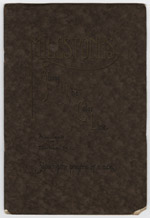 | Milestones along the color line. A souvenir of Durham, North Carolina showing the progress of a race Oliver B.Quick created Milestones Along the Color Line. A Souvenir of Durham, North Carolina Showing the Progress of a Race, to show property “owned and controlled exclusively by Negroes in the city of Durham, N.C.” In his preface he noted, “we have selected these [institutions and homes] as evidence of the progress being made by our race group in this section of the South.” The pamphlet contains numerous photographic images of churches, schools, business establishments, private residences and street scenes. | |
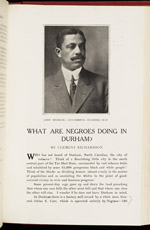 | What are Negroes doing in Durham? Essay by Clement Richardson in the Southern Workman highlighting the achievements of the African American community in Durham in the early 1910s. Richardson focuses on the contributions of black entrepreneurs and professionals including E. R. Merrick, Robert Fitzgerald, Stuart Lynn Warren, John Merrick, Dr. A. M. (Aaron McDuffie), R. H. Clegg, W. G. Pearson, J. S. Scarborough, E. W. Cannady, Dr. F. D. Page, Peyton H. Smith, P. W. Dawkins, Jr. and others. | |
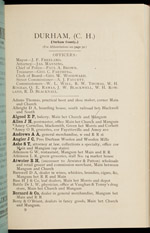 | Chas. Emerson’s North Carolina tobacco belt directory 1886 (Excerpt) This section of Emerson's 1886 directory lists businesses within the corporate limits of the town of Durham.The directory lists the names of proprietors, stores' locations and the products sold. Individuals with African American heritage are denoted by an asterisk (*). | |
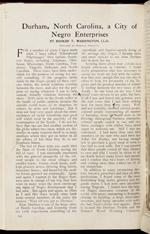 | Durham, North Carolina, a city of Negro enterprises Booker T. Washington, principal of Tuskegee Institute, penned this essay in 1911 for the illustrated magazine, Independent. Washington, recounts his travels to Durham and gives his observations about race relations in Durham. Washington discusses the economic and cultural contributions of many prominent members of the African American community including: Richard B. Fitzgerald, Aaron M. Moore, Richard E. Clegg, John Merrick, and Charles Clinton Spaulding. He devotes much of his analysis to the economic development of the black community in a place that he dubbed, “City of Negro Enterprises.” | |
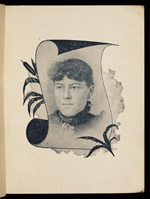 | My thoughts : A book of poems. With an introduction by James E. Shepard. M. Pauline Fitzgerald, one of Durham’s first African American school teachers, penned this self-published book of poetry. Pauline’s poetry memorializes Frederick Douglass, Dr. H. M. Tupper, founder and first president of Shaw University, and Bishop Daniel Payne of the A.M.E. Church. The collection also includes some more personal pieces including “An Ode to the First Colored Drug Store in Durham, North Carolina” and “The School Mistress.” Pauli Murray, author of Proud Shoes: The Story of an American Family relates a number of stories about her “Aunt Pauline” in her biographical account of M. Pauline Fitzgerald’s parents, Robert G. and Cornelia Fitzgerald. | |
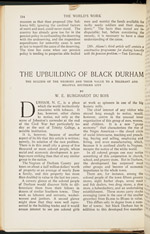 | Upbuilding of black Durham: the success of the Negroes and their value to a tolerant and helpful southern city Essay by W. E. B. DuBois in the World's Work reporting on his visit to Durham, North Carolina in 1912. DuBois analyzes the economic culture and explores the history of race relations in this southern city. DuBois provides a history of black enterprises and educational institutions that served the black community in Durham. The article features photographs of R.B. Fitzgerald, C.C. Spaulding, White Rock Baptist Church, North Carolina Mutual Insurance Company and a view of workers in a black-owned hosiery manufacturing company. | |
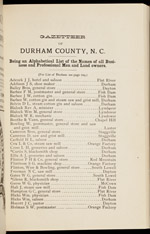 | Chas. Emerson’s North Carolina tobacco belt directory 1886 (Excerpt) This section of the 1886 directory entitled, Gazetteer of Durham County, North Carolina, lists 70 Durham County merchants and land owners, together with the name of the post office located nearest their businesses. Individuals with African American heritage are denoted by an asterisk (*). Occupations include hotel and saloon keeper, shoe maker, general store keeper and grocer, postmaster, mechanic and blacksmith, minister and pastor, saw and grist mill owner, physician, and cotton ginner. | |
 | Panoramic photograph of Parrish Street in Durham This panoramic view of Parrish Street (circa 1926) features the six-story headquarters of the North Carolina Mutual Life Insurance Company, a company established by black entrepreneurs, John Merrick, Dr. Aaron M. Moore, and Charles Clinton Spaulding. The firm's headquarters (as depicted in this image) was designed by Durham architects Rose and Rose and erected in 1921. Five years later, the building, located at 114-116 Parrish Street, housed the Mechanics and Farmers Bank, North Carolina Mutual Life Insurance Company, Mutual Building & Loan Association, and the Merrick-McDougald-Wilson Company. After North Carolina Mutual Life Insurance Company moved to its new headquarters on Chapel Hill Street in 1965, the old headquarters on Parrish Street was renamed the Mechanics & Farmers Bank building. The right panel of this photograph features the Durham County Courthouse (erected in 1916) and the Union Depot, both designed by Milburn and Heister Company, architects. | |
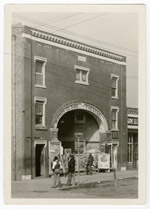 | Photograph of Wonderland Theater in Durham Photograph of the Wonderland Theater, located on the corner of Pettigrew and Ramsey streets. This theater, owned by "movie king" Frederick K. Watkins offered entertainment for Durham's black residents. A poster advertises The Barrier, starring Lionel Barrymore. | |
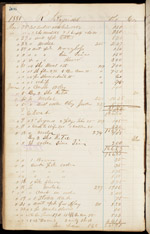 | Richard Fitzgerald account These pages from the Atlas M. Rigsbee, General Store ledger indicate what products, Richard Fitzgerald purchased from the Atlas M. Rigsbee General Store in 1880. Fitzgerald, an African American brickmaker, purchased a range of goods including foodstuffs like flour, meal, butter, sugar, and fish as well as lamp chimneys, collars and hats. The ledger indicates that Fitzgerald paid for his goods with bricks from his manufacturing enterprise. | |
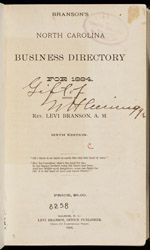 | Branson's North Carolina business guide This section of the guide contains physical attributes, land values, livestock values, taxes, and population statistics for Durham County. Branson notes that Durham County's population was 13,000, of which 8,500 were white and 4,500 were black. Also provided are the towns that had a post office, as well as county officers, court hearings, townships, magistrates, churches, pastors, and denominations. For individuals, Branson lists the name, nearest post office, and occupation. Edward James Parrish and Blackwell's Warehouse bought advertising space in the guide. | |
digitaldurham@duke.edu · About this site · Copyright © 2001 - 2006. Trudi J. Abel. All Rights Reserved.
The copyright interest in the material in this digital collection has not been transferred to the Digital Durham project. These text and images may not be used for any commercial purpose without the permission of the David M. Rubenstein Rare Book & Manuscript Library and the Digital Durham Project. Copyright permission for subsequent uses is the responsibility of the user.
